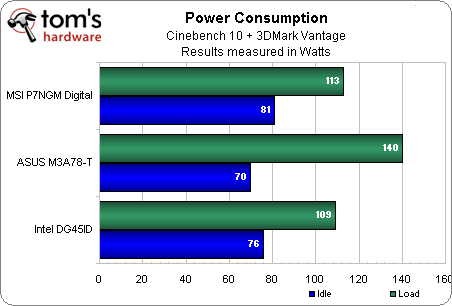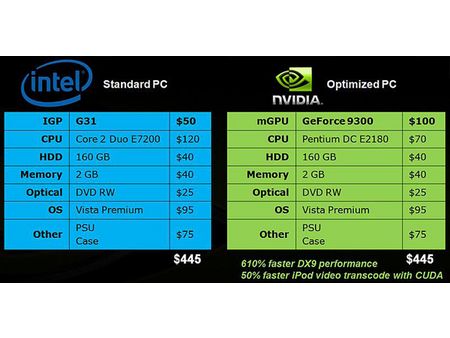Move Over G45: Nvidia's GeForce 9300 Arrives
Power And Pricing

At idle, AMD’s Athlon 64 X2 5400+ manages to achieve the lowest consumption numbers—a mere 70 W. The Intel platform sips 76 W, while Nvidia’s GeForce 9300 edges up past 80 W. Crank up the performance, though, and consumption quickly rises on the 790GX-based board. Meanwhile, the Intel and Nvidia boards hit 109 and 113 W, respectively. Overall, Intel holds the edge in power consumption against Nvidia, if only by a few watts.
Bear in mind also that dropping a GeForce GTX 260 or 280 into a 9300-based platform will not save you additional power as the system idles. Nvidia disclosed to us that it is satisfied enough with advances made to the power consumption of its newest GPUs that it won’t support Hybrid Power on the GeForce 9300. That feature didn’t last long, did it?
Pricing
All of the hardware in this three-way comparison is the same, save motherboards, processors, and the add-in graphics cards used to test GeForce Boost and Hybrid CrossFire. That makes it easy to size up these solutions based on their cost.
According to Nvidia, GeForce 9300-based motherboards will be priced in the neighborhood of $100. Add the Core 2 Duo E7200 we used for testing, and you’re looking at a $220 combination. Pair the ASUS M3A78-T 790GX board and the Athlon 64 X2 5400+ we used and you’re looking at $227—right around the same neighborhood. Finally, combine the Intel DG45ID and Core 2 Duo E7200 for a total price of $230, just a couple of dollars more expensive. So, you have three different choices within a $10 range—which do you pick?
Get Tom's Hardware's best news and in-depth reviews, straight to your inbox.
-
Ryun Good article but I feel compelled to say that I don't understand your choice for pitting the 790GX (~$140 board) and a 5400+ (~$80) with an the E7200 (~$120) and the G45 (~$100).Reply
Wouldn't it have made more sense to pair up similarly priced components, such as the 780g and 5400+ vs a E2180 and G45? Maybe someone could explain the reasoning? -
ricstorms I think a better Intel processor for an apt comparison should have been the E5200, which is only about $10 more expensive than the 5400+. Also, no mention was made that the 790GX platform is much more versatile, thanks to its 2 PCIExpress x16 slots (albeit running in x8 mode in Crossfire). Also, I would have liked to see the overclocking results with all three platforms, that is one of the strengths of the 790GX platform. (since AMD processors have fallen from grace, its almost impossible to find good reviews, I didn't see one in a google search for the 5400+ black edition)Reply
I think that the 780g platform is more analogous to the 9300. I would have liked to seen either a 8650 or a 6000+ competing on that than a 5400 on the 790GX, many of its features are not being used here. That being said I still think the Nvidia/Intel platform would fair better. It seems to me that this article is at some points aimed at gamers and at other home theater enthusiasts. I think the article would have been better suited focusing on either one, not both. -
chaohsiangchen I agree with Ryun about the price comparison.Reply
Cheapest G45 board is around $109 from Intel (discarding ECS) on newegg. G31 is outdated.
$100 730i board would be pitted against G45 board directly.
780G boards are slightly cheaper and still more capable then NVIDIA MCP7x and any Intel IGP solution. JetWay is offering JetWay HA07 790GX/SB750 board for $90 on newegg at the moment.
-
Reynod I still don't understand how you can say the AMD system draws less power at idle then declare the Intel system to be the winner i nthe power stakes??Reply
Can you please explain that one?
I would hardly put a 5400+ in a HTPC either ... I'd throw in a low power dual core ... bet that would make mincemeat out of the Intel systems and still give quality playback and much smoother graphics up on the screen.
Plus we all know the NVidia Graphics chips in this iteration are defective ... why buy a defective mobo to begin with?
It might not last very long.
Doesn't make good purchasing sense.
Even Apple are publicly stating that all current GPU's have defective substrates causing bonding issue, reducing the lifeltime of the GPU largely based on thermals I guess.
The E7200 is a good performer ... very good in fact. -
Liuqyn if they had done that, then they would have had to admit that AMD was still the better value for entry level gaming and HTPC use.Reply -
marees I agree perfrectly with Ryun that you cant compare e7200 with ath 5400.Reply
I would like to add that a phenom (8450?/9550?) processor should have been used because of the higher hyper transport speed advantages and also to check if the power consumtion is different.
Hopefully TomsHarware will update the figures including scores for phenom processor and also nvidia 8200/8300 chipsets for amd processors, just for completeness sake. -
chaohsiangchen ReynodPlus we all know the NVidia Graphics chips in this iteration are defective ... why buy a defective mobo to begin with?It might not last very long.Reply
Not true. Don't believe anything comes out from Charlie Demerjian until proven. -
Shadow703793 Well written! Next time do you mind posting a bit on if the board is capable of OCing a bit?Reply -
cangelini ryunGood article but I feel compelled to say that I don't understand your choice for pitting the 790GX (~$140 board) and a 5400+ (~$80) with an the E7200 (~$120) and the G45 (~$100).Wouldn't it have made more sense to pair up similarly priced components, such as the 780g and 5400+ vs a E2180 and G45? Maybe someone could explain the reasoning?Reply
Ryun,
The Intel- and AMD-based platforms both add up to $220. Assuming all other components are the same (memory, HDD, PSU, etc), you end up with two machines that cost the same amount of money. -
cangelini ricstormsI think a better Intel processor for an apt comparison should have been the E5200, which is only about $10 more expensive than the 5400+. Also, no mention was made that the 790GX platform is much more versatile, thanks to its 2 PCIExpress x16 slots (albeit running in x8 mode in Crossfire). Also, I would have liked to see the overclocking results with all three platforms, that is one of the strengths of the 790GX platform. (since AMD processors have fallen from grace, its almost impossible to find good reviews, I didn't see one in a google search for the 5400+ black edition) I think that the 780g platform is more analogous to the 9300. I would have liked to seen either a 8650 or a 6000+ competing on that than a 5400 on the 790GX, many of its features are not being used here. That being said I still think the Nvidia/Intel platform would fair better. It seems to me that this article is at some points aimed at gamers and at other home theater enthusiasts. I think the article would have been better suited focusing on either one, not both.Reply
Hi Rick!
You're right on the money about the 790GX's support for CrossFire. I'll look for a place in the piece to add mention of that. The 790GX chipset isn't going to add anything to overclocking in this particular comparison, though, since it's not a Phenom in the socket, but an Athlon 64 X2.
I believe this platform is best suited to an HTPC crowd, but I couldn't ignore Nvidia's insistence that gaming is good here as well. And to that end, I'd still recommend an add-in board under $100 like AMD's Radeon HD 4670.

